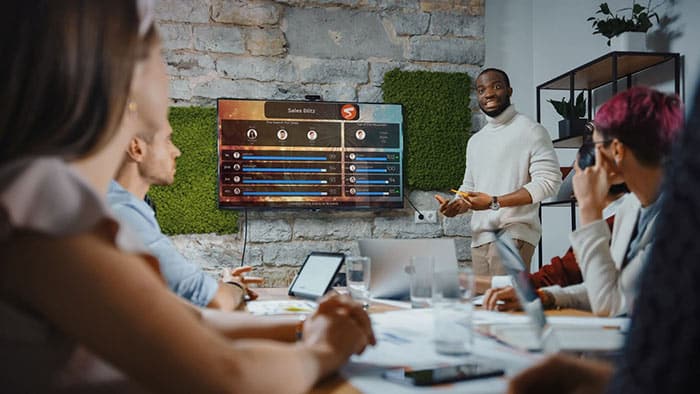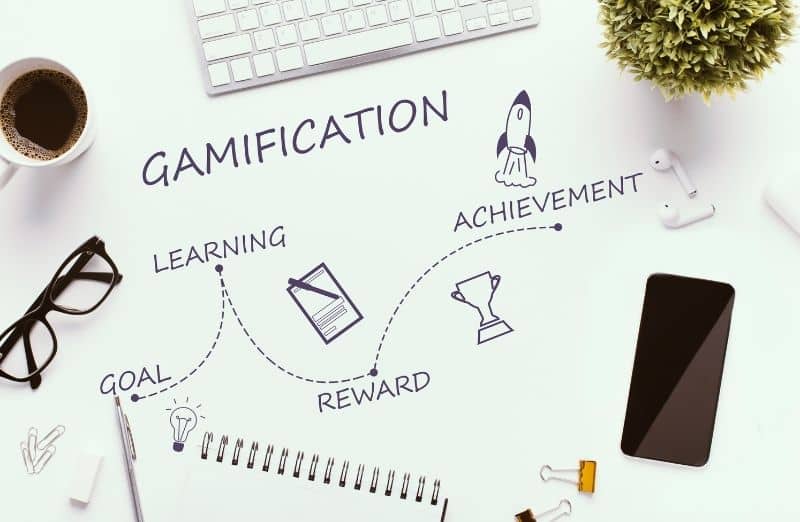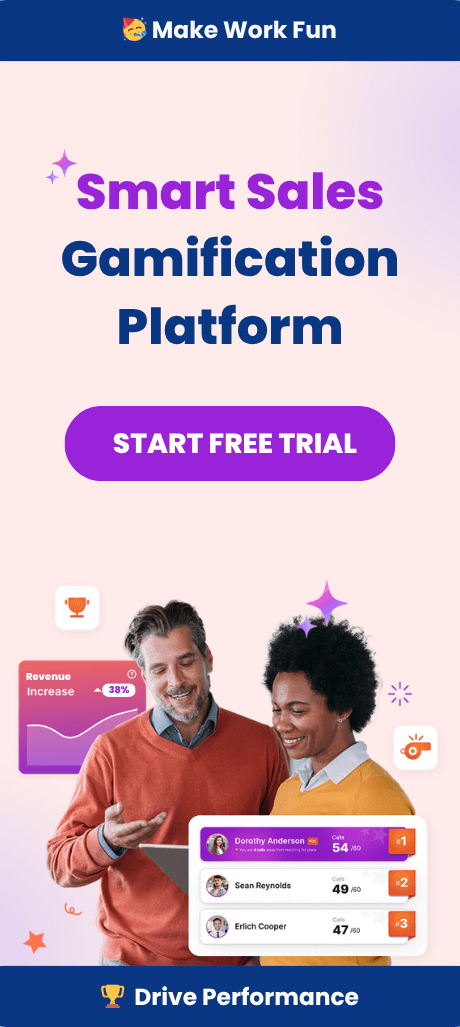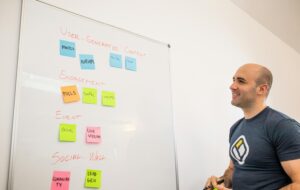Why Gamification Is a Sales Game-Changer
Sales floors are high-energy environments that thrive on performance and results. But even the most motivated sales teams can face slumps. That’s where sales gamification comes in—a powerful approach that turns routine sales tasks into engaging challenges that boosts motivation, improves skills, and drive performance and revenue. Gamification transforms mundane activities into exciting quests where every call, email, or meeting counts toward a bigger goal. This energizes the team, creating an atmosphere where effort is rewarded, and success feels within reach.
Gamification works by leveraging psychological principles such as competition, achievement, and instant feedback to enhance engagement and deliver measurable results.
By integrating game mechanics, sales gamification keeps reps focused and inspired. Gamification makes sales training and daily activities more engaging and effective by incorporating elements like leaderboards, badges, and real-time feedback. It fuels a sense of achievement and friendly competition that pushes everyone to raise their game. When sales reps see their progress in real time and earn recognition for their efforts, motivation skyrockets. This approach not only drives short-term wins but builds lasting habits that elevate the entire sales floor’s performance.
What Is Sales Gamification?
At its core, sales gamification uses game elements like leaderboards, points, badges, and rewards to influence behavior. These are known as gamification elements—such as badges, points, and friendly competitions—that help motivate sales teams, improve job satisfaction, and foster a sense of community. It introduces healthy competition among sales reps and encourages them to consistently achieve their sales goals while having fun. These game-like elements turn everyday tasks into engaging activities, making the sales process feel less like work and more like a challenge to conquer. By applying specific gamification techniques, organizations can further enhance motivation and performance among their sales teams.

Gamification also fosters a culture of continuous learning and improvement. By breaking down big goals into smaller, achievable milestones, sales reps stay motivated and focused. Digital gamification applications can be used to create interactive sales dashboards that motivate users to engage and perform desired tasks. Whether climbing leaderboard rankings or unlocking badges, the excitement of earning rewards keeps the team energized and eager to push further, driving overall sales success.
The Psychology Behind Gamification
Gamification taps into intrinsic motivators like achievement, recognition, and status. Neuroscience supports this too—earning rewards releases dopamine, making sales reps feel good and reinforcing continuous improvement in the sales process. This natural reward cycle encourages reps to repeat positive behaviors and strive for higher performance.
Moreover, gamification satisfies fundamental human desires for competition and social connection. Leaderboards and team challenges create a sense of belonging and shared purpose. Gamification also fosters a greater sense of accomplishment and positivity among sales reps, enhancing morale and work satisfaction. When sales reps feel recognized and valued, their engagement deepens, leading to higher productivity and a more vibrant, motivated sales floor.
Proven Benefits of Sales Gamification
From higher engagement to better sales performance, companies can implement sales gamification tools to drive team engagement and revenue. The results? Increased pipeline velocity, improved customer interactions, and more accurate performance metrics. Gamification has also been shown to improve performance across the sales team by leveraging techniques like leaderboards, badges, and real-time feedback. It uplifts morale and fosters a culture where success is celebrated at every level.
By making sales goals visible and rewarding progress, gamification helps sales reps stay focused on what matters most. It transforms the sales floor into a dynamic environment where everyone is motivated to contribute, collaborate, and excel. The positive impact extends beyond numbers, boosting team spirit and long-term growth.

Building a Gamification Strategy That Works
An effective gamification strategy aligns directly with your company’s business goals. Define clear objectives, identify target behaviors, and ensure that game mechanics encourage both individual and team performance. This tailored approach guarantees that gamification drives meaningful results, not just superficial engagement.
Successful strategies also include regular monitoring and iteration. By analyzing performance metrics and regularly gather feedback, you can refine game elements to keep the sales team challenged and motivated. When gamification is thoughtfully designed and continuously optimized, it becomes a powerful engine for sustained sales success.
Choosing the Right Sales Gamification Software
Selecting the perfect sales gamification software is crucial for maximizing your team’s potential. Tools like Spinify offer dynamic real-time dashboards, interactive leaderboards, and customizable competitions that seamlessly integrate with your CRM, making it easier than ever to track progress and celebrate wins. Incorporating gamification into your company’s tech stack can further enhance productivity and sales performance by leveraging modern technological solutions. The right software adapts to your team’s unique workflow, boosting productivity while keeping motivation high.
Beyond just tracking, the best platforms provide insightful analytics and instant feedback, empowering sales managers to make data-driven decisions. By choosing software that aligns with your sales process, you create an engaging environment where every rep feels supported and driven to excel, turning daily tasks into thrilling challenges.
Defining Key Metrics for Gamification Success
To truly harness the power of gamification, it’s essential to define clear performance metrics that matter. Track vital indicators like call volume, closed deals, upsells, meeting set rates, and sales numbers to pinpoint where your sales team shines and where there’s room to grow. These metrics provide a roadmap for targeted skill development and focused motivation.
By highlighting these key areas, gamification transforms abstract goals into tangible milestones, making progress visible and rewarding. When sales reps see how their efforts directly impact these metrics, they stay engaged and driven, fostering a culture of continuous improvement and measurable success.
Creating Sales Contests That Drive Engagement
Sales contests inject excitement and urgency into the daily grind, turning routine tasks into thrilling competitions. Whether it’s competing for “Top Closer of the Week” or rallying the team around the highest call volume, contests give sales reps a clear, tangible goal to chase and a chance to shine. These friendly competitions foster team bonding and motivation, helping sales teams improve performance while maintaining a fun, engaging work environment.

These contests foster friendly competition that energizes the entire team, encouraging reps to push beyond their limits. With well-designed contests, you not only boost motivation but also create memorable moments that build camaraderie and a winning culture on your sales floor.
Leveraging Team Challenges to Foster Collaboration
Team challenges are the secret sauce for building camaraderie and collective success. By setting group goals like team-based revenue targets, you encourage cooperation and shared responsibility, transforming individual efforts into powerful team achievements. Team challenges also promote greater collaboration and collective motivation, as employees work together more closely to reach shared objectives.
These challenges cultivate a sense of unity and mutual support, motivating team members to collaborate, share strategies, and celebrate wins together. When the whole team rallies behind a common goal, engagement soars, and the sales floor buzzes with energy and purpose.
Aligning Game Mechanics with Sales Tasks
For gamification to truly resonate, game mechanics must mirror real sales activities. Rewarding reps for cold calls, follow-ups, demos booked, and closing a sale ensures that the game reflects the daily grind and encourages consistent effort, not just occasional big wins.
By awarding points for effort and consistency, you reinforce positive behaviors that drive long-term success. This alignment keeps the game authentic and meaningful, motivating sales reps to stay engaged and focused on the actions that truly move the needle.
Encouraging Peer Recognition and Shoutouts
Peer recognition is a powerful motivator that builds a vibrant, supportive sales culture. Shoutouts on leaderboards or reward systems spotlight achievements, fostering a sense of pride and belonging among team members. Immediate recognition is especially valuable, as it reinforces positive behaviors and motivates employees by providing instant feedback and acknowledgment.
This positive reinforcement encourages reps to celebrate each other’s successes, boosting morale and inspiring everyone to raise their game. When recognition comes from peers, it carries extra weight, creating an environment where encouragement fuels ongoing motivation and collaboration.
Integrating Gamification Into Daily Standups
Morning standups are the perfect opportunity to keep gamification front and center. Reviewing scores, sharing successes, and motivating underperformers during these huddles maintains visibility and accountability for the game. These meetings also help keep the team engaged and motivated by providing regular feedback and recognition.
This daily ritual energizes the team, turning routine meetings into moments of inspiration and friendly competition. By weaving gamification into standups, you create a consistent rhythm that keeps motivation high and the sales floor buzzing with excitement.
Customizing Rewards and Tangible Incentives
Tailoring rewards to your team’s preferences is key to keeping motivation high. Whether it’s gift cards, extra PTO, or exclusive office perks, tangible incentives should feel valuable and within reach. When reps know their efforts translate into meaningful rewards, they’re more likely to stay engaged and push harder toward their goals. Personalized incentives are especially effective at fostering long term engagement, helping to sustain motivation and commitment over time.

Personalized rewards also foster a stronger connection between individual achievements and company appreciation. By mixing up incentives to suit diverse tastes and recognizing different types of success, you create a dynamic environment where every rep feels seen and motivated to contribute consistently.
Using Real-Time Leaderboards for Instant Feedback
Real-time leaderboards are the heartbeat of healthy competition. By instantly updating scores, they keep reps energized and aware of where they stand at every moment. This immediacy sparks urgency and drives reps to close gaps or defend their positions, turning the sales floor into a dynamic battleground.
Moreover, live leaderboards create a shared experience, uniting remote and in-office teams alike. Everyone gets to celebrate wins as they happen, fostering camaraderie and collective momentum. When reps see their progress in real time, motivation isn’t just maintained—it skyrockets.
Celebrating Milestones and Personal Bests
Marking milestones and personal bests fuels a culture of achievement and pride. Whether it’s a record-breaking quarter or a first major deal, reaching the finish line in team activities or sales objectives deserves public recognition that amplifies the joy of success and inspires others to aim higher. These celebrations turn everyday wins into memorable moments that energize the entire team.
Highlighting individual progress also reinforces positive behaviors and commitment. When reps see their hard work acknowledged, it boosts confidence and encourages them to set new goals. Celebrations become more than just applause—they’re powerful motivators that keep the sales floor buzzing with enthusiasm.
Promoting Consistency Over One-Time Wins
Sustained success beats occasional glory. Gamification should reward steady pipeline building and daily habits, not just flashy deal closings. By recognizing consistent effort, you cultivate discipline and resilience, essential traits for long-term sales success.
Encouraging reps to focus on the process rather than just outcomes creates a healthier, more balanced sales culture. When daily actions are valued, reps stay engaged and motivated through ups and downs, building momentum that leads to lasting results.
Engaging Remote and Hybrid Teams
Gamification bridges the gap for remote and hybrid teams, keeping everyone connected and motivated regardless of location. Platforms like Spinify deliver real-time updates and digital celebrations that make remote reps feel part of the action, breaking down barriers and fostering inclusion.
By creating shared goals and virtual moments of recognition, gamification ensures no one misses out on the excitement. This connectivity boosts morale, strengthens team bonds, and drives performance even when the team isn’t physically together.
Managing Fairness in Game Design
Fairness is the foundation of a successful gamification program. Avoid rewarding only top performers by designing tiered competitions and varied game types that give every rep a chance to shine. This inclusivity keeps motivation high across the board.
Balanced game design fosters healthy competition without discouragement. When everyone feels they can compete and contribute meaningfully, engagement soars, and the sales floor becomes a supportive, high-energy environment where all team members thrive.
Rotating Game Formats to Prevent Burnout
Variety is the spice of gamification. Rotating game formats—from individual sprints to trivia contests on product knowledge—keeps the experience fresh and exciting. Novelty sparks curiosity and prevents the team from losing interest over time. Regularly changing up the formats helps ensure team members do not lose interest, maintaining high engagement throughout.
By mixing up challenges, you cater to different strengths and learning styles, keeping everyone engaged and eager to participate. This dynamic approach ensures gamification remains a powerful tool for sustained motivation and continuous improvement.
Training Sales Managers on Gamification Tools
Empowering sales managers with the right gamification tools is the cornerstone of a successful program. Training them on platform features and strategic use equips managers to coach their teams effectively, turning data into actionable insights. When managers understand how to leverage leaderboards, badges, and real-time feedback, they become motivational champions who inspire consistent sales performance.
Beyond technical skills, managers learn to foster a culture of healthy competition and continuous improvement. Their leadership transforms gamification from a simple tool into a dynamic driver of engagement, boosting morale and helping every rep reach their full potential.
Motivating New Hires Through Onboarding Games
Onboarding sets the tone for new hires, and gamified training makes it unforgettable. Interactive quizzes, progress bars, and leaderboards turn learning into a fun challenge, accelerating ramp-up time and boosting confidence. New reps quickly grasp essential sales skills while feeling part of the team from day one.
This engaging approach reduces overwhelm and builds early momentum. By celebrating small wins and encouraging participation, onboarding games create a positive first impression that fuels long-term motivation and commitment, setting new hires up for lasting success.
Creating a Culture of Friendly Competition
A thriving sales floor buzzes with energy fueled by friendly competition. Establishing norms that celebrate effort, support, and shared goals keeps competition positive and inclusive. When reps view contests as fun challenges rather than cutthroat battles, collaboration and morale soar.
This culture encourages everyone to push their limits while cheering on teammates. Friendly competition helps each sales professional reach peak performance by fostering mental focus and perseverance. It sparks innovation, drives sales success, and builds a united team spirit where every member feels valued and motivated to contribute.
Connecting Gamification to Larger Business Goals
Linking gamification to strategic business objectives adds powerful purpose to play. Whether boosting NPS scores, expanding markets, or enhancing customer interactions, gamified goals align daily efforts with big-picture success. This connection transforms routine tasks into meaningful milestones.
Sales reps see how their progress impacts company growth, deepening engagement and accountability. Gamification becomes more than a game—it’s a strategic tool that drives measurable outcomes and fuels long-term business achievements.
Using Feedback Loops to Improve Systems
Continuous improvement thrives on open communication. By regularly gathering feedback from sales teams, managers learn what’s working and identify areas for refinement. This real-time input keeps gamification fresh, relevant, and effective.
Feedback loops empower reps to shape their experience, fostering ownership and enthusiasm. Iterating your gamification strategy based on genuine insights ensures sustained motivation and maximizes impact across the sales floor.
Balancing Fun and Pressure on the Sales Floor
Gamification should energize, not overwhelm. Striking the right balance between fun and pressure keeps reps engaged without burnout. Setting achievable goals and encouraging breaks ensures the game remains a positive force.
This balance nurtures resilience and creativity, allowing sales professionals to thrive under healthy challenges. When gamification feels rewarding rather than stressful, it becomes a sustainable motivator that drives consistent sales performance.
Building Dashboards That Tell a Story
Effective sales dashboards do more than display numbers—they narrate progress and potential. Visualizing who’s leading, improving, or lagging creates a clear, compelling story that guides action and inspires effort. Dashboards also help track and improve the team’s performance by providing real-time insights into achievements and areas needing attention.
These dashboards highlight paths to success, making goals tangible and motivating reps to close gaps. When data tells a story, it transforms performance management into an engaging journey toward shared victory.
Reinforcing Coaching Moments with Game Data
Gamification data is a goldmine for personalized coaching. Sales managers can use real-time insights to tailor 1:1 sessions, pinpoint strengths, and address growth areas with precision.
This data-driven approach makes coaching more impactful and relevant, helping reps develop targeted sales skills. By reinforcing progress and setting clear improvement paths, gamification turns coaching into a powerful catalyst for individual and team success.
Highlighting Top Performers to Inspire Others
Celebrating top performers isn’t just about recognition—it’s about setting a powerful example for the entire team. Sharing their success stories in meetings or internal newsletters creates role models that others can aspire to emulate. These stories highlight the strategies, habits, and mindset that drive exceptional results, inspiring reps to elevate their own game.
By spotlighting achievements openly, you foster a culture of excellence and motivation. When team members see their peers rewarded and recognized, it ignites a healthy competitive spirit and encourages everyone to push harder toward their own milestones, fueling collective sales success.
Using Gamification in Cross-Department Initiatives
Gamification isn’t just for sales—it’s a game-changer for cross-department collaboration too. Imagine creating contests that unite marketing and sales teams around shared goals, like accelerating lead conversions or boosting campaign effectiveness. This approach breaks down silos and fosters teamwork, turning collaboration into an engaging challenge everyone wants to win.
By gamifying joint initiatives, you build stronger alignment and communication between departments. Friendly competition and shared rewards motivate teams to work smarter together, accelerating pipeline velocity and driving faster, more impactful business results.
Driving Lead Management and Conversion Through Gamification
Gamification offers a powerful boost to lead management and conversion, turning what can be a tedious process into an exciting challenge for sales teams. By applying game mechanics—like challenges, leaderboards, and rewards—to lead management tasks, sales reps are inspired to go the extra mile in converting prospects. Sales gamification software can track and rank reps based on their lead conversion rates, with top performers earning rewards and public recognition.
This friendly competition not only motivates sales reps to hit their sales targets but also encourages them to refine their approach and share best practices with the team. As a result, the sales process becomes more efficient, with less time wasted and more leads moving swiftly through the pipeline. Sales managers can use these insights to identify high performers and areas for improvement, ensuring that every team member is engaged and striving for sales success. By making lead management a game, you create a dynamic environment where everyone is eager to play—and win.
Integrating Gamification with Customer Relationship Management (CRM)
Taking sales gamification to the next level means integrating it directly with your Customer Relationship Management (CRM) system. By connecting a sales gamification tool with your CRM, sales teams can track progress toward sales goals in real time, receive instant feedback, and earn rewards for hitting key milestones—all within the same platform they use every day. This seamless integration keeps sales reps focused and motivated, as every activity and achievement is automatically recognized and celebrated.
Sales managers benefit from a holistic view of sales performance, using CRM data to fine-tune their gamification strategy and drive continuous improvement. This approach not only boosts employee engagement but also ensures that gamification efforts are always aligned with broader business goals. By leveraging CRM insights, teams can optimize customer interactions, identify new opportunities, and sustain long-term success. Regularly gathering feedback from both sales teams and customers helps keep the gamification program fresh, relevant, and effective—ensuring your sales floor remains a powerhouse of motivation and achievement.
Evolving Your Gamification Strategy Over Time

A static gamification program quickly loses its spark—evolution is key. As your team grows and dynamics shift, continuously updating game rules, rewards, and formats keeps the experience fresh and exciting. This adaptability prevents burnout and helps keep engagement high, maintaining high engagement levels over the long haul.
Regularly refreshing your gamification approach also allows you to respond to feedback and changing business priorities. By staying agile, you ensure the game always aligns with your sales goals and team motivations, creating a sustainable engine for ongoing performance improvement.
For more insights, check out this Salesforce blog post that discusses the benefits and effectiveness of sales gamification tools, highlighting supporting data.
Measuring ROI on Sales Gamification Tools
Understanding the return on investment (ROI) of your sales gamification tools is essential for proving their value. Track metrics like increased close rates, shorter sales cycles, and improved customer retention to see how gamification drives tangible business impact. These insights help justify ongoing investment and inform strategic adjustments.
Beyond numbers, consider softer benefits like boosted morale, enhanced employee engagement, and stronger team cohesion. Together, these outcomes paint a comprehensive picture of how gamification transforms your sales floor into a high-performing, motivated environment.
Learning from Leaders: Real-World Success Stories
Industry leaders embraced gamification to supercharge their sales floors, yielding remarkable results. Their teams experienced surges in activity levels, deeper employee engagement, and a vibrant culture of motivation and achievement. These success stories demonstrate gamification’s power to elevate performance at scale.
By studying these examples, you can glean best practices and innovative ideas to tailor your own gamification strategy. Real-world wins prove that when executed thoughtfully, gamification isn’t just a trend—it’s a proven pathway to sustained sales success.
Overcoming Common Pitfalls in Gamification
Even the best gamification strategies can stumble if not carefully managed. Avoid pitfalls like unclear game rules, unfair scoring systems, or overly intense competition that can alienate team members. Using the smart framework to set clear and actionable goals helps prevent confusion and keeps everyone aligned. Setting smart goals—specific, measurable, achievable, relevant, and time bound—enhances motivation and clarity, ensuring that objectives are well-defined and deadlines are explicit. Keeping the focus on fun and continuous improvement ensures the program remains inclusive and motivating.
Transparency and fairness build trust and encourage participation. Regularly soliciting feedback and iterating on your approach helps you spot issues early and refine the experience. By navigating these challenges thoughtfully, you create a gamification environment that drives lasting engagement and peak sales performance.
Supercharge Your Sales Team with Spinify
Gamification is no longer a gimmick—it’s a proven, strategic tool for enhancing sales team performance. With the right approach and platform like Spinify, you can transform your sales floor into a results-driven, motivated powerhouse of engagement.
Ready to see the transformation firsthand? Try Spinify today and take your sales success to the next level.




